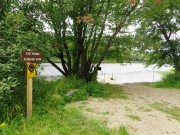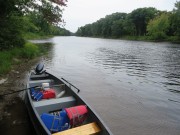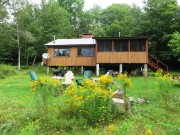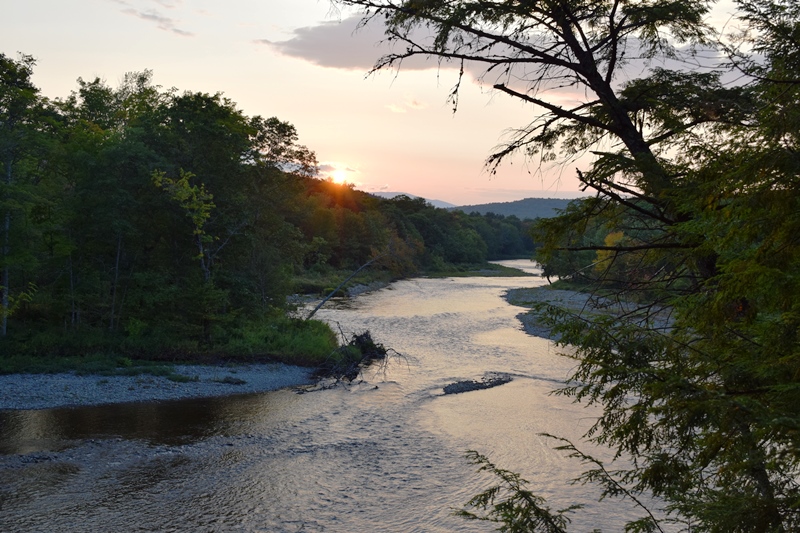
The Lunksoos [pronounced lunksue] area of T3 R7 WELS includes stunning views of the East Branch of the Penobscot River and historic sites such as the Hunt Farm and Lunksoos Camps. In 2014 it was also the local headquarters of Elliotsville Plantation foundation’s “Lunksoos Base Camp.” Not to be confused with Elliotsville Township (once a plantation) in Piscataquis County. The area is now within the Katahdin Woods and Waters National Monument.
The term “lunksoos” is said to be the Native American concept of “Indian devil,” or “catamount,” (a wild cat) or “wolverine.”
All this is reminiscent of 19th century lore expressed by Henry Clay Watson in Thrilling Adventures of Hunters, in the Old World and the New. He recounts an adventure “reported by boys” as follows:
“There is an animal in the deep recesses of our forests, evidently belonging to the feline race, which, on account of its ferocity, is significantly called ‘the Lunk Soos;’ a terror to the Indians, and the only animal in New England of which they stand in dread. You may speak of the moose, the bear, and even the wolf, and the red man is ready for the chace and the encounter. But name thee object of his dread, and he will significantly shake his head, while he exclaims, ‘He all one debil!’ (p.296)
Famously, Henry David Thoreau passed through the area in 1846, camping along the way. Nearly a century later, in 1939, 12-year old Donn Fendler was found near Lunksoos Camps, having been lost hiking Mount Katahdin.
The Hunt Farm, built by William Hunt in 1835, became a source of supplies and lodging for woods workers and travelers alike. It was south of the confluence of the Wassataquiok with the East Branch of the Penobscot. According to John Hakola, it was “the last outpost of civilization on the East Branch.” In 1845, Edward Everett Hale and Charles Channing were the first to take the East Branch and Wassataquiok route to Mount Katahdin.
Hakola quotes Hale as reporting that the Hunt Farm was “a large, rambling place, partly built of logs and partly of frame” in a clearing “grass and grain covered sweeping down the hill to the river” a position which “is for picturesque beauty unsurpassable.” After one night at the farm, they went north a half mile where they landed on the north bank of the Wassataquiok and began their hike to Katahdin.
^ Red-Tailed Hawk at Lunksoos
In about 1832 both William H. Hunt and Hiram Dacey and saw opportunities for lumbering, and soon thereafter for entertaining travelers, along the East Branch of the Penobscot River. They were then both involved in the area of what is now T3 R7 WELS and T4 R7 WELS, in and around the Katahdin Woods and Waters National Monument.
Hunt Mountain (photo at right) may be seen from the East Branch and from Katahdin’s Hunt Trail, recalling William Hunt’s contribution to the area’s history.
Hunt cut a rough road, now the Swift Brook Road, from Stacyville westward to the site of his farm above Whetstone Falls in T3 R7 WELS. About the same time Hiram Dacey built a smaller farm at what is now Lunksoos Camp, two miles north of Hunt’s farm. In the late 1870s the Dacey buildings began to deteriorate. In 1880 C.R. Patterson, former owner and operator of the Hunt Farm, bought the old Dacey place and built new houses for guests, with the names: The Patterson House, and later, the East Branch House.
Around the late 19th century, the firm of Ayers and Rogers reopened the old road system, rebuilt some of the camps in the area, and expanded logging up the Wassataquoik Stream. They established their headquarters at the old Dacey Farm site. Later Rogers built an elaborate log sporting camp on the site and named it Lunksoos. In 1902 Edwin Rogers developed a saddle horse trail to Katahdin’s Great Basin. In 1903 Artist George C. Hallowell escaped a great fire by lodging at Lunksoos. Soon thereafter, the Rogers promoted the “Lunksoos Trail” to the Great Basin. In 1820 Percival P. Baxter joined a trip to the Great Basin. He marveled at the sites and the mountain’s features, and apparently decided then and there to find a way to protect it.
By the 1940s and 1950s many of the sports camps ceased to be in private hands, some having been integrated into Baxter State Park. However, at the time of the establishment of Katahdin Woods and Waters National Monument in 2016, the Lunksoos site was still privately owned.
More Videos!
Additional resources
Fendler, Donn. Donn Fendler, lost on a mountain in Maine: a brave boy’s true story of his nine-day adventure alone in the Mount Katahdin wilderness / as told to Joseph B. Egan. Somersworth. New Hampshire Pub. Co., c1978.
Hakola, John W. A Legacy of a Lifetime: The Story of Baxter Park. TWB Books. Woolwich, Me. 1981.p. 14-15.
Neff, John W. Katahdin: An Historic Journey. Appalachain Mountain Club Books. Boston, Massachusetts. 2006.
Watson, Henry C. Thrilling Adventures of Hunters, in the Old World and the New. Boston, Ma. Kelley & Brother. 1953. http://books.google.com/books?id=hk1DAAAAIAAJ&pg=PA296&lpg=PA296&dq=%22lunk+soos%22&source=bl&ots=YYAAYchHgR&sig=8vsIMDsh965agWBOZaAogf6eOIM&hl=en&sa=X&ei=VBMKVNXuBob8yQTTroKABA&ved=0CEUQ6AEwBA#v=onepage&q=%22lunk%20soos%22&f=false (accessed September 5, 2014)







